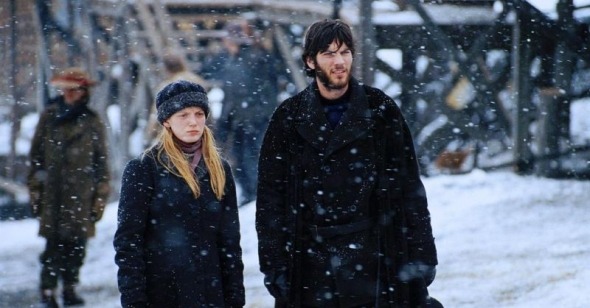Through the Keyhole
Mark Asch on The Claim, pan-and-scan, and the space beyond the TV screen
“When [David Fincher] shoots in 6K there is so much extra space in the frame,” Gone Girl editor Kirk Baxter recently told Adobe.com. That is, your modern digital movie camera records more pixels than are necessary for the resolution of state-of-the-art 4K digital theatrical projection. So, Baxter continued, “We can move shots around later, reframe, stabilize, and perfect a shot. For me, it’s helpful because I’m picking the performances that are the best, not the camera work that is the best.” Similarly, Ruben Östlund has spoken of his preference for shooting dozens of takes in a single fixed master shot with a hi-def digital camera: he can dedicate his on-set attention to performance, and then find the frame in postproduction, through a process of digital pans and zooms (like Ken Burns!).
Conceptually, this sort of process is not so dissimilar to the digressive zooms in a Robert Altman long take, or the responsive handheld camerawork of DPs like Eric Gautier and Yorick Le Saux, in their collaborations with Arnaud Desplechin and Olivier Assayas: the eye roams freely within the staged activity, alighting on the crucial moment or telling detail within the whole narrative word. But when this decision-making process happens after the process of “image capture,” Fincher or Östlund, attending to the essential content within a photographed image, become analogous to the anonymous technicians behind that much maligned format, pan-and-scan. Pan-and-scan, the frame-by-frame rerecording of a selection of a film image matching the proportions of a standard television, is generally acknowledged by right-thinking people to be a “butchering of the director’s vision,” with huge swaths of the cinematic image bartered away in exchange for posttheatrical profits. But surely it also involves aesthetic choices, even if made under less favorable, less free conditions than those made by a Fincher or an Östlund. Can these choices ever make a positive contribution to our experience of a movie?
First off: until the end of the twentieth century, as every schoolboy knows, television screens were wider than tall at a ratio of 4:3; this is perfect for broadcasting films in the “Academy” aspect ratio in which all Hollywood features were shot up until the fifties and sixties—when competition from television, as well as more diverse production circumstances, fostered a variety of wider aspect ratios. In order for movies to be broadcast on television, or, later, recorded onto VHS, a film, often a second-generation 16mm print, would be run through a telecine machine and transferred to videotape. As the National Association of Broadcasters Engineering Handbook laments, "Film has a wide variety of aspect ratios, nearly all of them considerably wider than 4:3." One option is letterboxing, retaining the original width of the image; the other option retains the original height of the image. The handbook continues:
"[A] portion of the [widescreen celluloid] image, selected by an operator, is digitally shifted to the left and right in a spatial processor to keep the most important action or scene content within the television frame limits. As the action moves within the film frame, the shifting function follows it dynamically. This mode is known as pan-scan. Because of the impracticality for an operator to perform this continual adjustment in real time, pan-scan transfers first require a learning pass in which the telecine is stopped whenever the center of action moves, and the pan-scan control factor is adjusted and recorded in a list synchronized by time code or a film counter. For the subsequent transfer, an execution pass is then carried out; the telecine's control system continually reads the pan-scan list and applies the changing stored control values in real time to the spatial processor."
It is this process from which originate many of the pan-and-scan horror stories about movies on television and VHS: not just your bog-standard evisceration of breathtaking landscape and well-composed crowd scenes, but indifferently “center cut” transfers with no attempt to track movement, tips of noses talking to tips of noses from the extreme left and right of frame while waves crash in the background; constant panning in “live” scans with the frame always chasing the actors in response to dialogue or edits; antic shot-reverse shot patterns made out of unbroken master takes; even the different cinematographic styles of the telecine operators at different networks.
Though the process would later improve somewhat, for reasons I’ll get to in a little bit, the basic problem with pan-and-scan remains the same: the loss of as much as half of the widescreen image, including both visual information and compositional balance.
Although the shift to DVDs and other digital mediums, and the accompanying industry assumption of a more connoisseurial home-video viewing audience, thankfully seems to have made letterboxing more prevalent, pan-and-scan remains: while the introduction of widescreen (16:9) televisions minimizes issues with the common European and American non-anamorphic widescreen ratios of 1.66:1 and 1.85:1, ‘Scope ratios continue to be regularly cropped on movie channels and Netflix, while fans of older Academy-ratio movies, and most TV reruns, face an entirely fresh hell. Things can sometimes feel not so removed from the dark days of the 1990s and early 2000s, when the U.S. News and World Report ran an article entitled, “Who Squashed the Image on My TV Screen?” (the “squashing” in question is the black letterbox bars running above and below the properly proportioned image), and Video Business published a Letter to the Editor, in the July 9, 2001 edition, reading, in part, “I like pan-and-scan because none of the available resolution is wasted on drawing the black bars.” There will always be people who care more about their TVs than what’s on them.
On the other hand, there's no need to divide up the audience (as much reportage and industry literature seems to casually do) into the aesthetes who really understand and appreciate the art form, and the philistines who don’t. Sensitivity to aspect ratio (and irritability at its alteration) is clearly a learned attitude: panned-and-scanned TV broadcasts and VHS tapes are how most cinephiles my age and older first encountered many of the major films in our lives. Certainly, based on our subsequent moviegoing trajectories, the sense that something was fatally wrong with these panned-and-scanned classics was not foremost in our minds.
So, with this piece, I want to look at what, exactly, we saw, and what I think that means. I’ll do that by revisiting a film whose pan-and-scan presentation struck me, at the time I rented it, in the dying days of VHS, as a pinnacle of the pan-and-scan format: Michael Winterbottom’s 2000 drama The Claim.
*****
The Claim transposes the plot outline of Thomas Hardy’s The Mayor of Casterbridge to the mythic American West. Successful gold prospector Dillon (Peter Mullan) is the man in charge of Kingdom Come, a mining town in the Sierra Nevadas, maintaining law and order and romancing the local saloonkeeper (Milla Jovovich), but things are thrown off balance by the arrival of Dalgliesh (Wes Bentley), a surveyor for the transcontinental railroad, and by the widow Mrs. Byrne (Nastassja Kinski) and her daughter, Hope (Sarah Polley). The latter two are the wife and child he, as a brash, drunken young immigrant fortune-hunter, traded away to ’49er Byrne in exchange for the claim to Kingdom Come.
For its setting, The Claim leans heavily on Robert Altman’s McCabe & Mrs. Miller: the snowbound, remote Western town (on a set built in the mountains of Alberta, Canada); the character of the plucky frontier madam and the theme of the corporate gentrification of the wild West; the color palette, with a frosty blue tone to the exteriors and a sleepy golden haze for the interiors; and most of all, the sense of an unruly frontier world within the margins of the narrative, and beyond them.
Winterbottom’s stylistic hallmarks—an at-the-ready camera; frequent, lively cutaways—give his films a bracingly roughed-up, elliptical feel (which sometimes camouflages narratives tending towards the obvious). The Claim was shot and exhibited in 2.35:1 anamorphic widescreen, the version I finally watched on DVD recently. There are indeed widescreen landscape vistas throughout The Claim, but for every classical use of negative space and majestic mountains, there’s another long-shot exterior taken in handheld, quaky telephoto, or from an unconventional angle. Most often, the use Winterbottom makes of the frame’s width is to populate it, filling it with extras in motion in the street and saloon scenes. The Claim features fewer of Winterbottom’s unpredictable mid-scene cutaways—to exteriors or close-ups—than, say, the Trip films, possibly because The Claim stretched his resources thinner. But he still makes frequent use of his extras, framing them in off-center close-ups as they drink, laugh, or react to the action. The camera in The Claim doesn’t move a great deal, but is generally handheld, hovering around people and objects as if poised and ready for them to sprint off in any direction. Faces and things sometimes dip in and out of frame, or in and out of focus—most often in extreme close-ups, but in handheld master shots as well.
The slipperiness of attention within a shot fits with the rhythm of the editing. Winterbottom shoots more coverage than he needs, often from “bad” angles, and seems to cut faster the more people there are in a scene. He often shoots over shoulders or through glass; in the saloon scenes especially, a favored technique is to place a natural light source out of focus in the foreground of a telephoto close-up or two-shot; this, along with the imperfect and asymmetrical angles, places the viewer into the scene with the characters—as though the camera is edging sideways through the players, like a concertgoer carrying a round of drinks back to his friends. When, for instance, Sarah Polley stands on stage in the saloon to recite a ballad about the tragedy of leaving home, the scene's on-the-nose commentary is all but subsumed by its texture: the frequent spatial reorientation of the camera, and parallel dialogues among the rest of the cast and frontier-burlesque action worked up among the extras.
For all that, though, frame-by-frame, The Claim in anamorphic widescreen tends toward a single focal point, and a swirl of surrounding activity—even when the camera circles a man screaming in despair against a desolate landscape, he’s centered in the frame, a still point in a turning world. Returning to the film, I found it more legible, visually and narratively, than I remembered.
*****
I probably watched The Claim on a school break during the first half of college, in the early 2000s. By this time, the pan-and-scan process had improved considerably. During the 1980s, as Stephen Prince writes in A New Pot of Gold: Hollywood Under the Electronic Rainbow, 1980-1989, studios allowed the use of "first-generation negative or interpositive" sources for video transfers, acknowledging the importance of the growing home video and cable markets (and the development of more advanced, sensitive telecine equipment) and allowing for much-improved image quality. The home-viewing cause was advanced further by the increasing digitization of the postproduction process. A 2002 Editor’s Guild Magazine article on the brave new world of digital intermediate includes pan-and-scan alongside color correction and cutting as one of the tasks which it would now be possible to perform before printing the locked picture back onto celluloid for exhibition; the 2001 edition of Dominic Case's Film Technology in Post Production advises that "Pans and scans are programmed during the grading session. It is desirable, though not always possible, to have the director of photography attend this session”—a far cry from the NEB Handbook advising telecine operators to watch the movie first. In “Who squashed the image on my television screen?”, Curtis Hanson tells the U.S. News and World Report that he supervised the panning and scanning of Wonder Boys for VHS, saying, “It's a step down but as good as it can be.”
When I rewatched the 2001 VHS of The Claim for this article, I should say right away, I found the differences from the theatrical and DVD versions to be subtler than I expected. Winterbottom’s quick cutting and zeroed-in, if hectic, framings, meant that most scenes played essentially the same in both versions. He prefers to group figures closely within a frame, whether packed with background activity or emptied of it, rather than distribute them across its width; and you’ll rarely see two actors in profile holding down opposite ends of a symmetrical two-shot. For that reason, I didn’t detect any added cuts in this edition of The Claim—no shot-reverse shot patterns made from the telecine operator cutting between two sides of the same frame.
Added cuts are one of the two less frequent, more assertive “stylistic” interventions common to pan-and-scan; the other is added camera movement, in which the captured 4:3 window moves across the surface of the original image to track movement. Though the full-frame VHS edition of The Claim is not “center-cut”—choices are made about positioning of the smaller frame within the larger one, and vary from shot to shot—the mobility and responsiveness of Winterbottom’s own camera, as well as his tail-chasing editing rhythms, minimize the need for added camera movements. There are, however, moments when Winterbottom blocks movement to take advantage of the full width of his frame, and the accompanying choices made on the VHS are revealing.
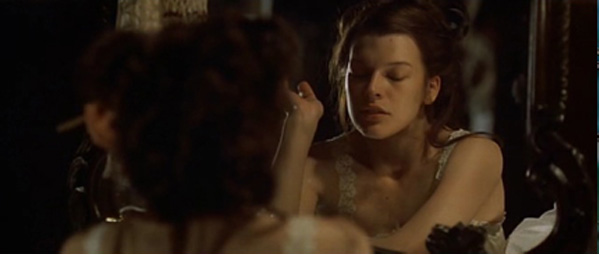
In this scene, cinematographer Alwin H. Kuchler’s camera is tightly framing Milla Jovovich as she looks into her dressing-table mirror, in a shot with a notably shallow depth of field. A few seconds later, as she turns to face Peter Mullan (his head is bobbing in and out of focus and frame in the extreme right-hand foreground), the camera racks focus from Jovovich’s reflection to her face:

Note that the camera has moved only a little: the edges of the frame maintain a basically consistent distance to the frames of the mirror. However, in pan-and-scan, the frame is too tight to hold Jovovich’s in-focus reflection and the out-of-focus back of her head at the same time:
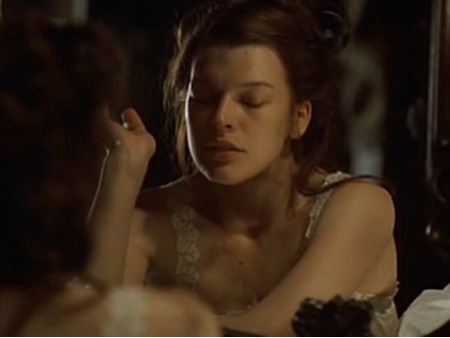
So, timed to Jovovich’s turn and the rack focus, there is a track across the surface of the image, from the right side of the above framing to the left of it, keeping her in-focus face centered in the frame. (Technical caveat: Here, and throughout this article, 4:3 images are cropped screengrabs from the widescreen edition mirroring as closely as possible the pan-and-scan compositions of the same frames, as paused on a monitor from which I was unable to pull screengrabs.)
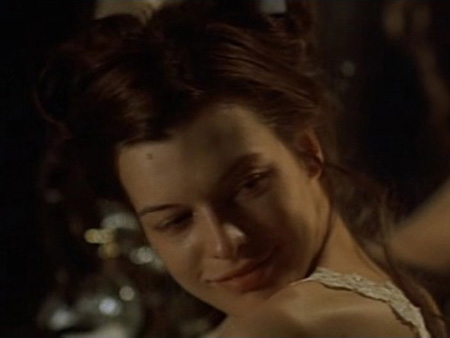
Now, this is a very subtle movement, and essentially it accomplishes the same thing as the rack-focus, which is to keep our attention on Milla Jovovich’s face. But because of the tunnel vision of the squarish pan-and-scan aspect ratio, the camera seems to follow the movement more intently, at the expense of other details. There’s at least one other such moment when the scan pans along with a rack focus; again the impression is of the camera chasing the activity with an intensity that feels physical.
This is more significantly the case in another moment that occurs about a quarter of the way in. Having just recited her poem in the saloon, Sarah Polley returns to the table in the back where her father (unbeknownst to her) is sitting with her love interest.
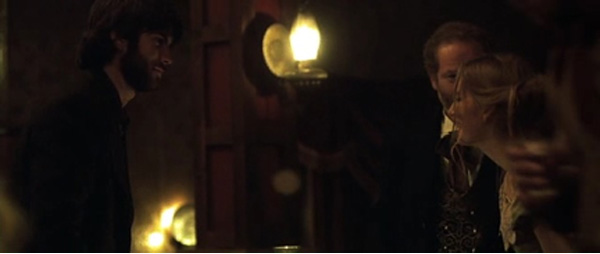
In this shot, which has been held as she approaches the table from the right, Bentley is in and out of frame as Mullan stands to pull out her chair for her. In pan-and-scan, however, we get the right half of the frame, Polley’s movement bringing us into the scene, while Bentley’s dialogue comes from offscreen:
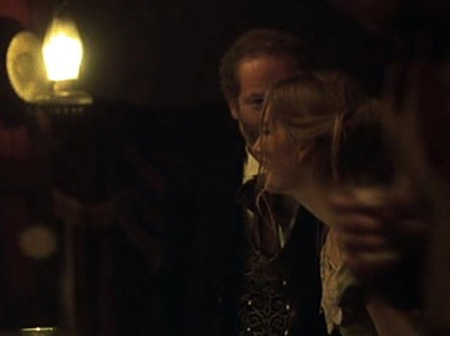
Subsequently in this shot, Bentley’s railroad colleagues cheer for him to sing, and the camera moves slightly to the left, centering him as he shouts back. In pan-and-scan, however, the frame follows the action more urgently than the camera, to the new focus of the scene, reassessing its opinion of what’s dramatically crucial here. This is done with a slightly haphazard feel: there is a split-second when no actors are prominent in the frame, as the 4:3 frame scurries from the right portion of the above frame to the left and the wall sconce briefly has the frame to itself...
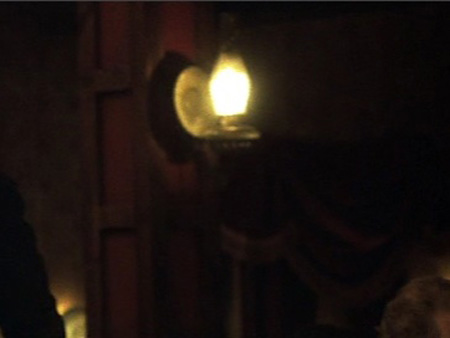
… before Bentley is discovered:
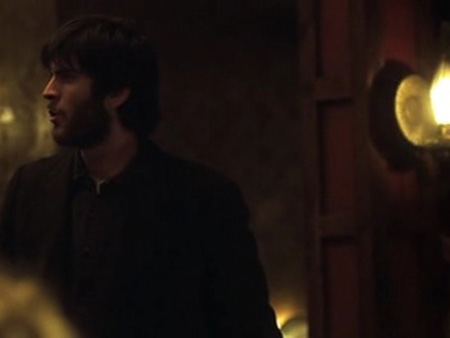
There’s a sense of unpredictability, of suspense over what the camera will find when it moves, which is missing from the more subtle re-framing in the widescreen edition.
That kind of diffuse energy also comes at times from the cropping of the widescreen image to fit a TV screen. In the early scene when Mullan and newcomer Bentley size each other up, Winterbottom twice uses this somewhat unconventional setup, in which Mullan is out of focus in the left foreground, with his right-hand man, Sweetley (Sean McGinley), in the middle ground alongside Bentley.
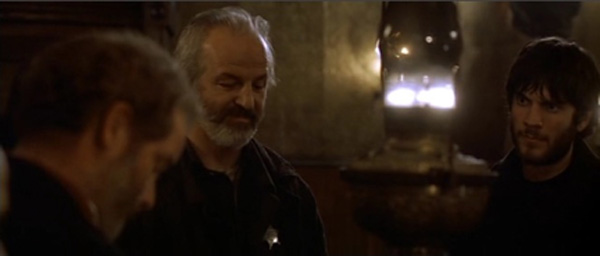
In this shot, Mullan is speaking, despite being out of focus; in pan-and-scan, rather than crop Mullan out of the image, leaving a lamp dead-center but getting Bentley’s in-focus reaction shot, the decision was made to crop out Bentley:
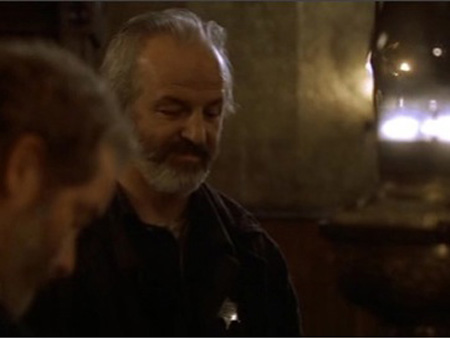
Here, Sweetley is smirking at what his boss has just said; thus, the only thing in focus in the pan-and-scan frame is the tertiary reaction of a tertiary character—a more emphatic presentation of the extra dramatic layers suggested by the original framing with Sweetley between the two.
This shot continues as Bentley speaks—from offscreen, in the pan-and-scan version. This happens innumerable times in the film: characters are cropped out of compositions, particularly two-shots, so that people frequently seem to be speaking into—or from—offscreen space.
Characters also extend beyond the frame in pan-and-scan. Bodies fit easily within two-shots composed for widescreen, but when the frame is narrowed to fit a TV, sudden movements often lead characters fully or partially offscreen. These sorts of imprecise compositions are among the classic irritations of pan-and-scan compositions, but in a film that strives for a sense of imprecision and fluidity, the unpredictability of their movement is another way to the bustle Winterbottom is clearly going for. Rather than action filling the frame, we get action bleeding through its borders: this is a lovely framing of Jovovich singing in the saloon…
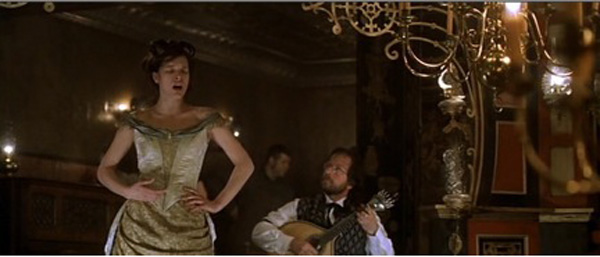
… but in the pan-and-scan version, the chandelier in the right foreground is almost entirely cropped out, so that we see only its gilt edge, extending into parts unknown, where the neck of the guitar also points:
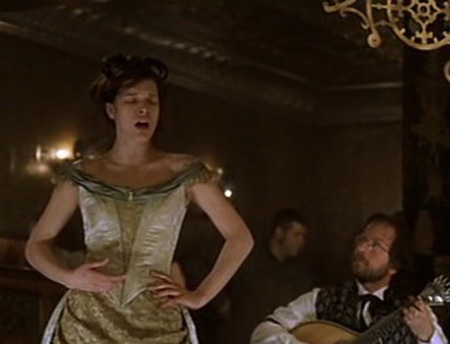
But while the cramped cropping suggests life outside the frame, more importantly, it implies an intense gaze within it. And so ultimately what I remembered as the vitality of the pan-and-scan version of The Claim comes less from a sense of roving attention than from a sense of heightened attention. In crowd scenes, the extras are seen to move through tighter spaces, between the main actors instead of around them, so that each frame feels like a concentration of human energy. The actors who remain in the frame are seen in tighter quarters—instead of a teeming frame, we get one that seems zeroed-in, voyeuristic. If the cutting of the film gives, in widescreen, the impression of stolen glimpses, this effect is intensified in full-frame, when details are tighter, faces especially.
A sense of perspective is lost along with the balancing presence of the expansive backgrounds in exterior shots, so the moment-to-moment current of the film seems much more volatile. With the loss of the negative space comes an increased intimacy. During the recital scene, when Polley’s father in the audience sees her on stage after all these years, we watch them in alternating close-ups. Tight framings, balanced compositions, telephoto lenses, and an eyeline match dissolve the space between them in a conventional way:
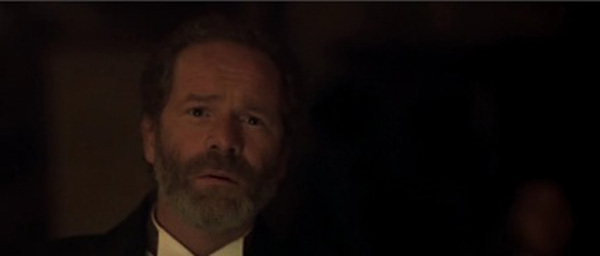
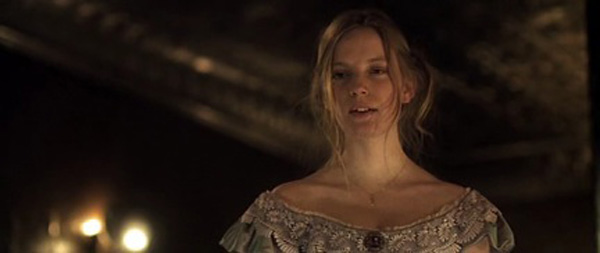
In pan-and-scan, we lose even the out-of-focus backgrounds:
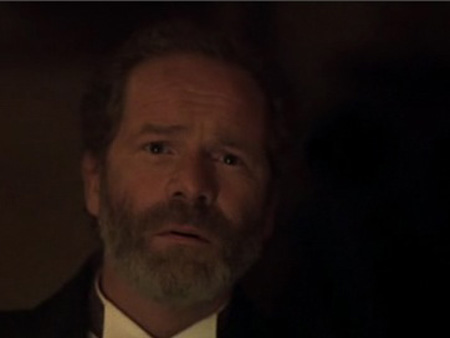
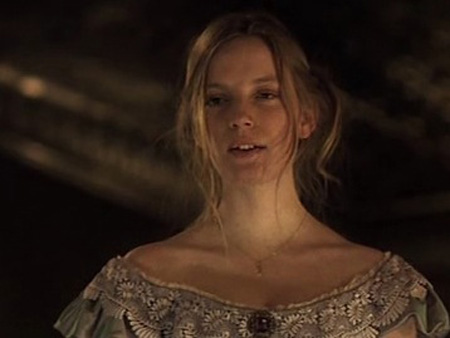
There are also a couple of additional factors which heighten this intimacy above and beyond what the altered aspect ratio does: if you watched this on a VHS, it’s likely that the top and bottom of the frame were also cropped, due to “overscan” (older TVs tend to lose the edges of the images they’re broadcasting, in all directions), making for an even closer, more imperfect framing. In all likelihood, due to the resolutions of older televisions, and the less subtle color contrasts available in the VHS format, you’re also seeing an even fuzzier background, and faces engulfed in candlelight rather than highlighted by it.
*****
Having spotlighted all these alterations, though, I should note that at least one academic study has found that aspect ratio does not significantly influence appreciation of the main determinants of viewer enjoyment—that is, story and character.
And indeed, The Claim is not a radically different film in widescreen versus pan-and-scan—though surely that’s partly because Winterbottom’s compositional style and narrative rhythms lose little in the translation. Nor, despite my very positive pan-and-scan experience with the film, do I have any interest in denying that the The Claim plays better, looks better, in its intended widescreen aspect ratio: there are at least a handful of beautifully scaled exteriors, the background cast and décor is well-utilized for a sense of place, and the style feels more assured, less muddled.
This is perhaps not so different from the typical aesthetic diminishments of pan-and-scan. But the messiness of those hustling tracking shots and cramped frames works for this film in particular—at least, that messiness prepared me for what was valuable about the film, even if it didn’t improve upon it. The pan-and-scan version of The Claim is an even more elusive thing than the original.
That elusiveness may be generally truer of the pan-and-scan VHS experience. One additional problem of the pan-and-scan process is that, as Prince writes, even under ideal transfer circumstances, with an attentive, artistic engineer at the helm to manipulate levels, videotape simply has a lesser resolution than celluloid, and can handle more limited ranges of brightness, color, and contrast. Videotape also degrades from wear and tear, and the conditions under which one watches VHS tapes are often sub-optimal, at the very least.
The Claim, through its loose, spontaneous style, tries something similar to the muffled sound design of McCabe & Mrs. Miller—to imply a life outside of the movie, one beyond the viewer’s grasp, as if we’re bundled up in winter clothes, moving too slowly to catch up, with a big fur hat blocking our ears and our peripheral vision. (McCabe & Mrs. Miller, which I first saw on home video as a teenager, remains my favorite movie, for its quicksilver, dreamy quality, that subsequent theatrical viewings have never quite dissipated.) Pan-and-scan puts even more of the movie out of our reach. And this is true of the format more generally—movies with a third of the picture cut away, watched on degraded tape, on old TVs with bad picture quality and shitty speakers. This, then, is the standard viewing experience I alluded to at the outset—the way cinema looked to those discovering it during the VHS era. The Claim is a movie consciously trying to feel like a mirage, a world barely glimpsed through a haze, but the strange miracle of pan-and-scan, for all its cruddiness, is that so much of film history should appear this way: as art with some of its mystery still intact.
